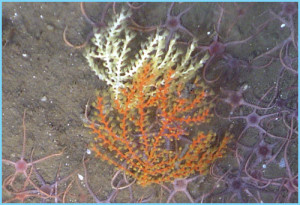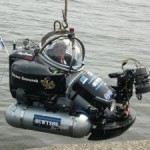
Michael Reuscher is a PhD student at Texas A&M University -Corpus Christi and a freshly minted submersible pilot engaged in the Finding Corals Expedition with Living Oceans Society. He has been reporting since June 5, sends this from the RV Cape Flattery, currently stationed off the coast of British Columbia.
Darkness in the submersible… Every 15 minutes I have to use my little flashlight to read the little gauges of all the vital systems: I am at 1500 feet. After devouring all these deep-sea books, attending deep sea classes and marveling at pictures taken from subs, I have bodily entered this alien domain.
The bottom around me is covered with brittle stars and anemones. Rock fish, sponges and cold water corals (Swiftia sp.) are also frequent dwellers here in the deep waters of South Moresby to the South of the island Haida Gwaii. With the manipulator arm, I was able to grab a stone with one of these small, white corals attached and bring it to the surface. Using a high definition camera we uncovered a fascinating microcosm: Several critters live on or in proximity to the corals, among the most intriguing ones a family clan of ghost shrimp (Caprellidae).

Before I hit the bottom I met some squids in the water column in panic from my looks, being the submersible’s of course. Aggressively, they tried to scare me back by ejecting their greenish-yellowish ink. Arrow worms, jellyfish, comb jellies, and different kinds of small crustaceans were frequent passersby on my ride to the bottom.
Besides the main purposes of the dives, the video transects and the sampling, there is also time in between to explore this fascinating remote place that probably no one has ever seen before. On one of my explorations, a halibut crashed into one of my HMI lights, leaving me startled, the fish bleeding and my light displaced. I hope the flatfish recovers from this hit.
I also saw a dazzling yellowish dome shaped object encircling a head-shaped silhouette. Top site supervisors must have been surprised when I told them that I see Tom in the other sub. What I did not know was that Tom’s sub that was launched at the same time was towed back on deck. The strong current made a synchronous dive too dangerous.
What I identified as the illuminated dome of the sub with Tom’s head turned out as a yellow sponge with a sea lily on it. When I told Tom that I saw a sponge that looks like him, he told me he would reconsider my grade of his class that I attended this spring semester.
Image courtesy Olympic Coast National Marine Sanctuary Deep-Sea Coral Photo Gallery.






I really enjoyed reading your post. How long does it take you to dive to 1500 ft? How long are you able to stay submerged? Really amazing stuff!
Hi Jen,
calculate about 1 min per 100 feet- probably a little bit more. On my first dive, however, I did a mid water transit. The reason for that was a current that pushed me into too deep water. So it took me longer until I hit bottom. We have about 2.5-4 hours down there. Then the batteries become weak and we have to come up. If they are so weak that your thrusters are not strong enough, you still can come up by filling your ballast tank with air. In an emergency you have air for appriximately 80 hours. You get also water bottles and special biscuits with 24000 calories. So, theoretically you can stay down for three days. Sylvia Earle actually spent a night submerged in the Gulf of Mexico.
Michael
Mid water transit sounds a liiitle scary. How is the visibility?
Yeah, I got some pats on the back for doing the midwater transect after my dive :)
The visibility in South Moresby was quite decent though. In Mid Moresby there was more sediment in the water. At the former one, the last greenish light (when you look up through your dome) fades to black between 600 and 700 feet, at the latter one already at about 450 feet.
The subs are not that fast (1.5 knots) so that you have enough time to avoid a crash :)
But check out the new sub design called Orca! This neat little toy has a top speed of five knots! You definitely want to have a good visibility for that. Here the link:
http://www.subaviators.com/Default.aspx?tabid=83&language=en-US